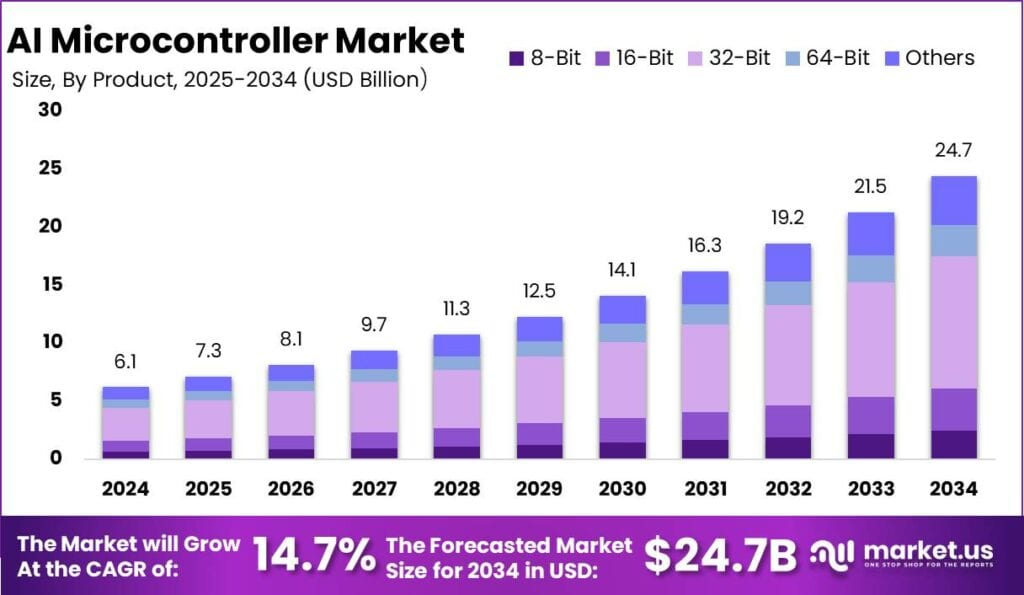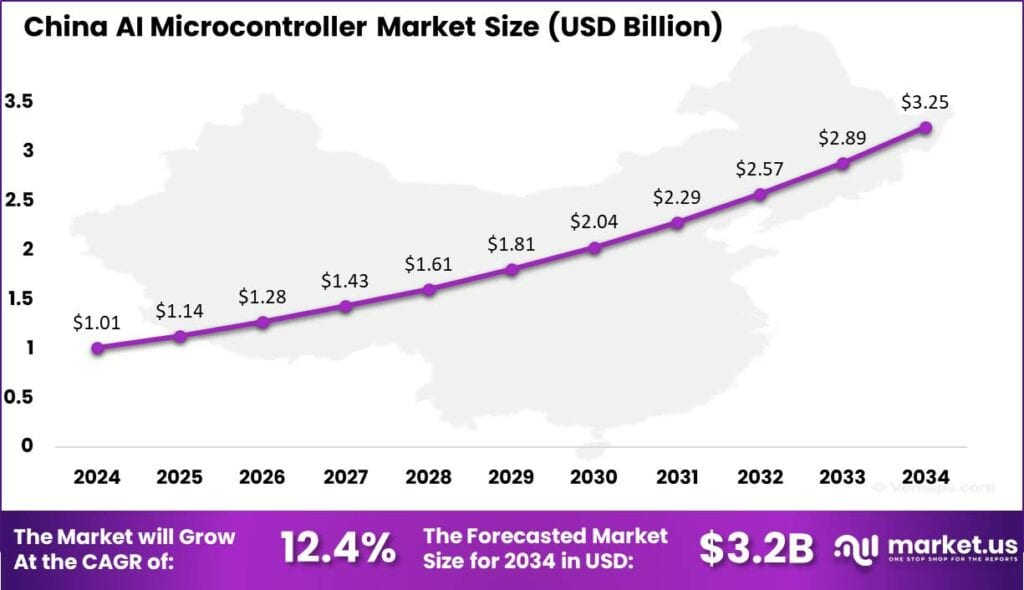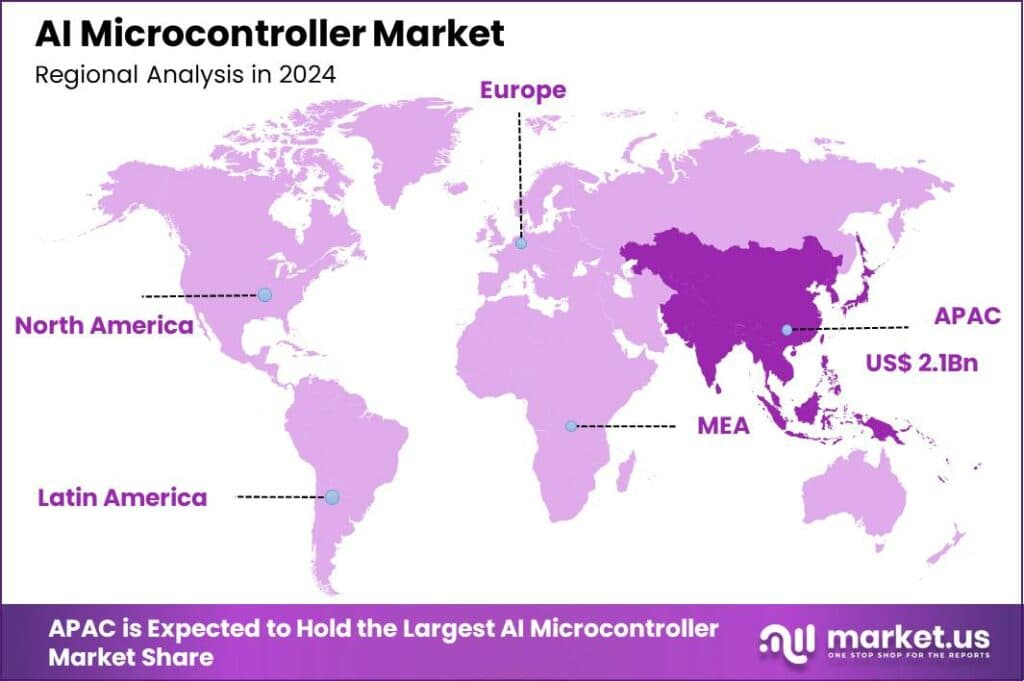WHAT WE HAVE ON THIS PAGE
Introduction
An AI microcontroller integrates artificial intelligence capabilities directly into a microcontroller unit (MCU). These devices are engineered to perform AI tasks such as machine learning and neural network processing within the constraints of low power consumption, compact design, and limited processing capabilities typical of embedded systems. The integration of AI into microcontrollers allows them to analyze data from sensors and execute decision-making processes in real-time, enhancing their ability to act intelligently without needing to connect to external computing resources.
According to Market.us, The global AI microcontroller market is on a strong growth trajectory, expected to expand from USD 6.1 billion in 2024 to approximately USD 24.7 billion by 2034, reflecting an impressive CAGR of 14.7% over the forecast period (2025–2034).
The market for AI microcontrollers is expanding as more devices require smart, real-time processing at the edge of networks. This market growth is driven by the increasing demand for IoT devices that require low power consumption and high efficiency for AI tasks. These microcontrollers are finding applications in various sectors including automotive, consumer electronics, and healthcare, where embedded AI can provide significant enhancements in operational efficiency and user experience

Among different microcontroller types, the 32-bit segment emerged as the clear leader in 2024, accounting for 46.7% of the market. These microcontrollers are widely used in AI applications due to their enhanced processing power and energy efficiency.
On the application front, Natural Language Processing (NLP) led the market, contributing to 38.4% of total revenue. The growing use of AI-driven chatbots, voice assistants, and real-time translation tools has significantly boosted the demand for NLP-powered microcontrollers.
When it comes to sales channels, direct sales remained the most preferred choice in 2024, capturing 54.5% of the market share. Companies are increasingly focusing on direct distribution to maintain quality control and build strong customer relationships.
The consumer electronics sector was the largest end-use industry, contributing to 36.5% of total market revenue. AI microcontrollers are becoming integral to smart home devices, wearables, and personal gadgets, driving significant demand in this segment.
Analysts’ Viewpoint
Key factors driving the AI microcontroller market include the rising demand for edge computing, the need for power-efficient AI computing at the edge, and the proliferation of IoT devices. The growing capabilities of microcontrollers to handle complex AI tasks thanks to advancements in TinyML and edge AI technologies also significantly contribute to market growth.
There is a robust demand for AI microcontrollers in applications requiring real-time, intelligent processing without the latency associated with cloud computing. This is particularly evident in wearable tech, smart home devices, and industrial IoT solutions, where quick, autonomous decision-making is crucial. As technologies such as TinyML advance, these microcontrollers are capable of supporting increasingly complex AI models.
Investment opportunities in the AI microcontroller sector are plentiful due to its rapid growth and the essential role these components play in advancing modern AI applications. However, risks include technological obsolescence due to the fast pace of technological advancement and the potential for market saturation as more players enter the market.
Recent technological advancements in AI microcontrollers focus on increasing the processing power while minimizing energy consumption and size. Innovations like integrated Neural Processing Units (NPUs) and the development of new frameworks for low-power AI operations exemplify these advancements. These improvements enable AI microcontrollers to perform complex computations such as image recognition and natural language processing more efficiently than ever before.
Regional Analysis
China, a major country in the APAC region, held a market value of USD 1.01 billion in 2024, growing at a CAGR of 12.4%. The country’s strong manufacturing capabilities and government initiatives supporting AI integration in electronics have fueled its market expansion.

The Asia-Pacific (APAC) region dominated the market in 2024, securing a 34.7% share and generating USD 2.1 billion in revenue. This growth is largely driven by rapid industrial advancements and increasing adoption of AI-powered devices.

Report Segmentation
Product Analysis
In 2024, the 32-bit segment of the AI microcontroller market held a commanding lead, securing a substantial 46.7% share. This dominance is underpinned by the segment’s enhanced computing capabilities and extensive application in sectors demanding high-performance computing such as automotive and industrial controls. The 32-bit microcontrollers, which handle more data and offer higher processing power compared to their 16-bit and 8-bit counterparts, are increasingly preferred for complex applications.
Technologies Analysis
The Natural Language Processing (NLP) technology segment was prominent within the AI microcontroller market in 2024, capturing a 38.4% share. This technology’s leading position can be attributed to its critical role in enabling devices to understand and process human language, an essential feature for enhancing user interactions with IoT devices and improving the automation of customer service and support tasks.
Sales Channel Analysis
Direct sales channels were the most effective distribution method for AI microcontrollers in 2024, accounting for over 54.5% of the market. This sales method’s effectiveness is largely due to the ability of manufacturers to directly engage with end-users, providing tailored solutions and technical support, which is particularly important for sophisticated technologies such as AI microcontrollers.
End-Use Industry Analysis
The consumer electronics sector was the leading end-use industry for AI microcontrollers in 2024, claiming more than 36.5% of the total market share. The prominence of this segment is driven by the rapid incorporation of AI capabilities into consumer electronics, including smart home devices, mobile phones, and wearable technology, which require advanced processing power for tasks such as voice recognition and real-time data processing.
Top Key Players in the Market
- Nvidia Corporation
- Advanced Micro Devices, Inc. (AMD)
- Alphabet Inc.
- Microsoft Corporation
- Qualcomm Incorporated
- STMicroelectronics NV
- Texas Instruments Incorporated
- Infineon Technologies AG
- NXP Semiconductors
- Others
Conclusion
The AI microcontroller market is witnessing rapid expansion, driven by advancements in AI-powered applications, rising demand for smart devices, and strong growth in the APAC region. With 32-bit microcontrollers, NLP applications, and consumer electronics leading the way, the industry is set for substantial development in the coming decade.
Sources:
- https://market.us/report/ai-microcontroller-market/
- https://www.peulic.com/about-microcontrollers/microcontrollers-and-artificial-intelligence-ai/
- https://www.irjet.net/archives/V9/i4/IRJET-V9I4404.pdf
- https://community.silabs.com/s/share/a5UVm000000ZzNBMA0/implementing-ai-and-machine-learning-on-microcontrollers
ABOUT AUTHOR
Yogesh Shinde is a passionate writer, researcher, and content creator with a keen interest in technology, innovation and industry research. With a background in computer engineering and years of experience in the tech industry. He is committed to delivering accurate and well-researched articles that resonate with readers and provide valuable insights. When not writing, I enjoy reading and can often be found exploring new teaching methods and strategies.










